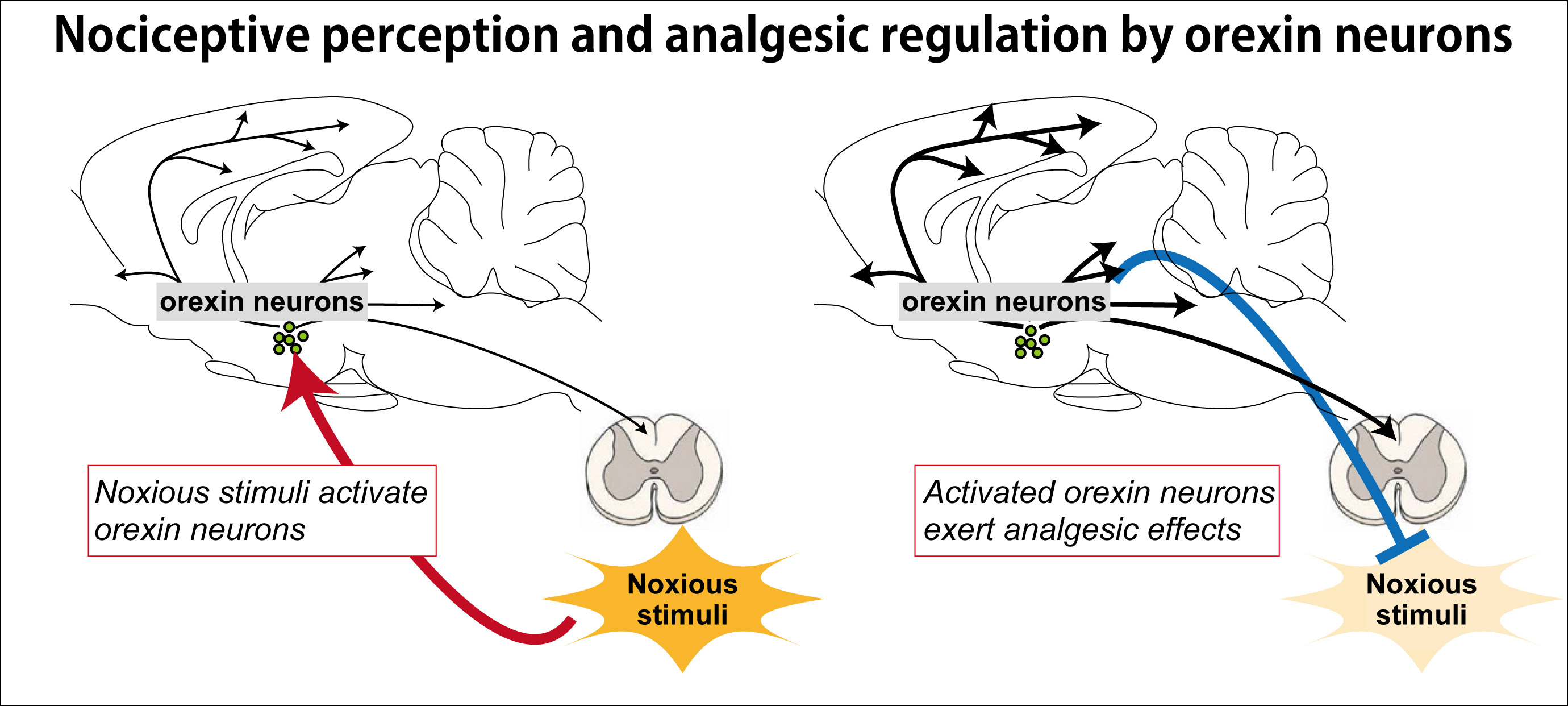Researchers centered at Nagoya University revealed a role for orexin neurons of the hypothalamus in regulating the response to harmful stimuli in mice. Painful stimuli activated orexin neurons, except in mice that were anesthetized. Mice bred to lack orexin neurons were hypersensitive to such stimuli, while those with artificially activated orexin neurons demonstrated reduced responses to pain. These findings suggest a link between response to stimuli and consciousness that is regulated by neurons producing orexin.
press released on July 15, 2016

Nagoya, Japan – An animal’s response to potentially harmful stimuli is known as nociception, and is determined, to some extent, by the level of consciousness. The absence of nociception or the inability to feel pain can cause an animal to unknowingly incur severe injury, while hypersensitivity to pain prevents quick defense responses to a threat to survival (the fight-or-flight response). Neurons in the hypothalamus that produce the neurotransmitter orexin (a chemical messenger) are known to control nociception, and to play a role in wakefulness and reward processing. Pathways involving orexin neurons are also important during the transition from sleep to wakefulness. However, the precise functioning of orexin neurons in nociception has remained unclear. A research team centered at Nagoya University has now uncovered a role for orexin neurons in the link between nociception and the inability to feel pain (analgesia) in mice. The study was recently reported in Scientific Reports.
The researchers bred mice with orexin neurons that could be selectively and temporally destroyed by a toxin. This specific cell death was controlled by the presence or absence of a chemical added to the animals’ food. Mice lacking orexin neurons were found to be more sensitive to nociception than control mice, as demonstrated by pain-related behaviors such as withdrawing their paws from a hot plate or licking paws injected with a chemical irritant. Conversely, the artificial activation of orexin neurons significantly decreased such pain-related behaviors, suggesting its analgesic effect.
Selective removal of orexin neurons also reduced neurons expressing another chemical messenger, dynorphin, within part of the hypothalamus. "This indicates that the analgesic effect of activating orexin neurons could involve the combined action of orexin and dynorphin, or other messengers," first author Ayumu Inutsuka says.
Development of a novel measurement system enabled the researchers to record real-time orexin neuronal activity. "We selectively engineered orexin neurons to express a calcium indicator that could be illuminated by an LED light source, and the resultant fluorescence was detected," corresponding author Akihiro Yamanaka explains. "Strong mechanical stimuli applied to the mouse tail in the form of pinching with forceps brought an increase in the indicator signal. No such response was elicited when weaker stimuli were used, nor when the mice were anesthetized."
Temperature-dependent increases of heat stimuli also induced a similar response, which again could not be detected under anesthesia, suggesting that anesthetics may function by inhibiting orexin neurons.
The article, "The integrative role of orexin/hypocretin neurons in nociceptive perception and analgesic regulation" was published in the Nature journal Scientific Reports at DOI:10.1038/srep29480
Authors
Ayumu Inutsuka, Akira Yamashita, Srikanta Chowdhury, Junichi Nakai, Masamichi Ohkura, Toru Taguchi & Professor Akihiro Yamanaka (Authors whose names are written by boldface belong or belonged to Research Institute of Environmental Medichine, Nagoya University.)
Related Links
A. Yamanaka’s Lab., Department of Neuroscience Ⅱ, Research Institute of Environmental Medicine, Nagoya University
Research Institute of Environmental Medicine, Nagoya University
Media Coverage
Funding
KAKENHI, CREST(JST), the program for Brain Mapping By Integrated Neurotechnologies for Disease Studies (MEXT/AMED).



